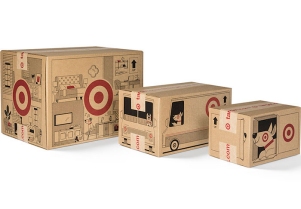
The Hot New Product Amazon and Target are Obsessing Over? BoxesThe humble cardboard box is the midst of a design revolution.  "Pulling in a Target box from my porch, I noticed it had a delivery van printed on the side with the Target dog Bullseye driving it. Minutes later my son was sliding the box around the carpet. Thanks to a bit of printing, the box was no longer a box. It was a car."
"Pulling in a Target box from my porch, I noticed it had a delivery van printed on the side with the Target dog Bullseye driving it. Minutes later my son was sliding the box around the carpet. Thanks to a bit of printing, the box was no longer a box. It was a car."
BY MARK WILSON May 8, 2019 (Fast Company) - Packaging is an ancient practice. Humans have been improvising containers for holding and transporting things for millennia, from baked clay vases to tanned leather satchels to sawed and nailed wooden crates. But it wasn't until the 1800s that cardboard boxes as we know them came about. Lightweight and disposable, they were first used in France in the 1840s to transport the delicate Bombyx mori moth to silk manufacturers — likely because it kept moths alive better than less breathable boxes. Around this time, several entrepreneurs began pushing the boundaries of paper. A top hat manufacturer realized he could pleat paper for the inner lining of his hats in 1856 and patented the process. “Corrugating” paper in such a way built up the bulk, tensile strength, and shock absorption of paper. By 1890 we had the corrugated cardboard box as we know it. And as a result, 20th-century shipping became about paper, not wood, as it had been previously. Go to any big retail store, and you'll see countless dyed paper and plastic packages on the shelves. But laying behind them, in the stock room? The corrugated boxes that shipped them there. And nowadays, thanks to Amazon Prime and the rise of fast shipping, these brown boxes are piling up on our doorsteps. “What you have is a situation where packaging was always very practical. The corrugated box has a fairly unceremonious life where it's meant to get from point A to B,” says Jesse Genet, founder of the packaging supply chain firm Lumi. “It's such a recent development that the corrugated box is coming directly to someone's home and has an opportunity to make an impression on someone.” Corrugated boxes, once the realm of stockrooms and UPS trucks, are now branding tools. And they are especially important, given that few of us ever interact with a brand in real life now. In the era of e-commerce, boxes are the new storefront. But it's not just direct-to-consumer startups that are seizing the opportunity. Now giants like Target and Amazon are rethinking the humble cardboard box, too. And they're doing it in a very brand-consistent way. For Target, it's all about sparking joy. For Amazon, it's all about efficiency. In each case, they are burnishing their brand through packaging. E-COMMERCE SITES USE RESTRAINED GLITZ AND GLAMLumi serves some of the biggest direct-to-consumer brands in the world, including Casper and Brandless. In some cases, it makes sense for the brand to embrace a basic cardboard aesthetic. Brandless is a perfect example of that, with a simple brown box with “Brandless” stamped on the side. The implication is that you're saving money by not having lots of expensive, colorful ink in your packaging. For the most part, if you've seen something on your Instagram feed — like organic shampoo or a meal delivery service — chances are good it came in a roll end tuck box. It's basically a shoe box that opens easily from the front. Because you line up the box a certain way before you open it, that allows retailers to arrange your goods in a premium-feeling reveal, like a gift basket. From there, the possibilities are only limited by budget. If a company wants to ditch the cardboard look, it might use a flood coat–basically coating the corrugate box in a bright dyed wrapper. Another company might add in cloth bags. It's even possible to get custom cornstarch packing peanuts in the shape of a logo. But millennials are mindful of wasteful packaging, and budget is a major concern for e-commerce sites, which is why you still see so much plain old cardboard in the mix. In fact, Genet founded Lumi to help other businesses manufacture their packaging only after she raised over $250,000 on a Kickstarter campaign for a line of light-sensitive ink kits, and saw firsthand that it would cost $90,000 to pack and ship products. “I had a line item in the budget, but no realistic understanding of what that stuff would cost,” she says. Cardboard packaging with a little something extra is the default for e-com companies that want to impress customers without breaking the bank. TARGET CHASES EXPERIENCETarget has a similar approach. To better compete with online competition from Amazon and every other online retailer, Target announced the introduction of free two-day shipping in 2018. For many shoppers, that changed their relationship to Target. Whereas they once defined Target as a place to grab some Starbucks and peruse nominally priced cookware, they now saw it as cardboard arriving on their doorstep. Earlier this year, I got a pleasant surprise. Pulling in a Target box from my porch, I noticed it had a delivery van printed on the side with the Target dog Bullseye driving it. Minutes later my son was sliding the box around the carpet. Thanks to a bit of printing, the box was no longer a box. It was a car. Weeks later, Khoi Vinh, a designer at Adobe, shared a similar experience on Twitter . . . . The full story is available on Fast Company's website: Fast Company. SOURCE: Fast Company |